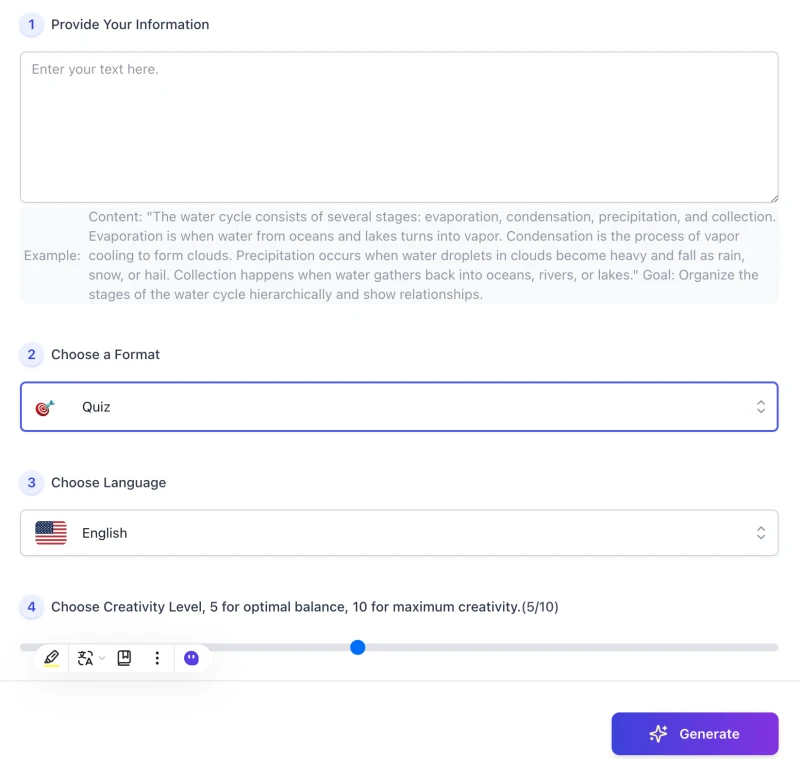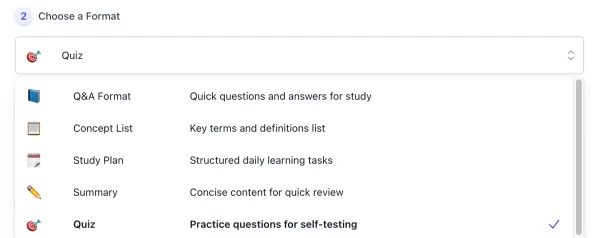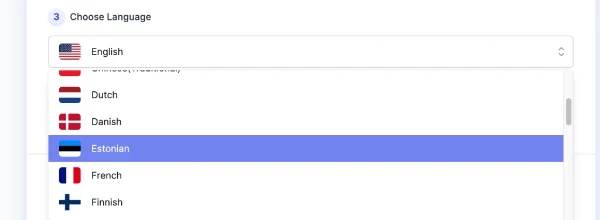Free AI Tools. No Sign-Up Required. Full Access.
AI Study Guide Generator
Free online AI tool to create study guides — no sign-up, perfect for students, teachers, and lifelong learners.
Combine the current tool with these other tools to work more efficiently.
Discover other tools with functions and purposes similar to the one you are currently viewing.
Discover the tools most favored and highly-rated by users on our website.
Explore more AI tools in these related categories
AI tools that automatically create text content for your images, audio, or video from user prompts.
Empower education with AI-driven tools for teaching and learning excellence.
AI tools designed to assist with research, studying, writing, and academic data analysis tasks.
This is the AIFreeBox AI Study Guide Generator online tool page — a learning assistant designed for students, teachers, and lifelong learners. It transforms raw study materials such as class notes, textbook excerpts, or reading passages into structured, actionable study guides that support efficient review and deeper understanding.
On this page, you will find a clear overview of the tool’s capabilities, ideal use cases, usage instructions, study tips, limitations, common troubleshooting steps, and FAQs. All focus to to make study guides practical and adaptable.
What Can AIFreeBox AI Study Guide Generator Do?
The AIFreeBox AI Study Guide Generator is built on advanced transformer-based large language models, fine-tuned for education. It is not a generic text generator, but a study-focused assistant designed to organize knowledge and support real learning.
It offers multiple structured formats — Quiz, Study Plan, Cornell Notes, Concept Lists, and Summaries — enabling learners to follow a complete cycle of input → practice → review → application. With 10 preset study styles and support for 33 languages, the tool adapts to diverse learning needs and contexts.
Its core value is transforming raw materials into personalized, structured, and verifiable study guides. AI handles extraction and organization, while learners bring judgment and insight. This human–AI collaboration ensures that guides remain accurate, practical, and aligned with real study goals.
AIFreeBox Study Guide Generator vs.Generic Text Generator
| 🔎 Dimension | AIFreeBox AI Study Guide Generator | Generic Text Generator |
|---|---|---|
| 🎯 Purpose | Study-focused; turns materials into guides | General prose creation |
| 🧩 Output Structure | Quiz, Study Plan, Cornell Notes, Concepts, Summary | Loose paragraphs; inconsistent sections |
| ✅ Verifiability | Evidence quotes; “Not in source” flags | Rarely cites source; risk of hallucination |
| 🧠 Learning Flow | Input → practice → review → application | No guided learning loop |
| 🎓 Study Styles | 10 presets (e.g., Cram, Feynman, Cornell) | No pedagogy-aware presets |
| ⚙️ Control | Fixed skeletons; concise bullets; difficulty tags | Unstable formatting; verbose by default |
| 🤝 Human–AI Role | AI organizes; learner judges and refines | AI tries to “finish” the text |
| 🌍 Language Fit | 33 languages; study terms localized | Basic translation; weak study phrasing |
Recommend Applicable Scenarios and Benefits
| 👥 Audience | Applicable Scenarios | Pain Points Solved |
|---|---|---|
| 🎓 Students | Exam preparation & daily revision | Condenses large chapters into review sheets |
| 🗒️ Learners with messy notes | Organizing class or lecture notes | Turns scattered notes into structured outlines |
| 📚 Test Takers | Quizzes, finals, standardized exams | Generates practice questions with clear answers |
| 🌍 Language Learners | Studying in non-native languages | Provides guides in 33 supported languages |
| 🔬 Researchers | Advanced study & concept exploration | Explains ideas using Feynman or Cornell styles |
| ⏱️ Busy Professionals | Part-time learning & skill upgrading | Creates time-bound study plans with milestones |
| 👩🏫 Teachers & Tutors | Lesson prep & teaching support | Prepares summaries, quizzes, and lesson aids |
| 📑 Graduate Students | Research projects & academic work | Extracts key concepts for papers & presentations |
How to Create a Study Guide with AIFreeBox AI:
Step-by-Step Guide

Step 1 — Provide Your Information
Paste your study material (notes, textbook passages, articles) into the input box. Keep the text focused for best results.
Step 2 — Choose a Format

Select how you want your study guide structured — Quiz, Summary, Study Plan, Cornell Notes, or Concept List.
Step 3 — Choose Language

Pick from 33 supported languages to generate a guide that matches your preferred language of study.
Step 4 — Adjust Creativity Level
Set creativity from 1 to 10. A mid-level score (around 5) balances accuracy and clarity, while higher levels add variety.
Step 5 — Generate Your Study Guide
Click Generate. The tool will transform your raw content into a structured and actionable study guide.
Step 6 — Download, Copy, or Report a Bug ( Real Human Support )

Once the guide is ready, you can Download it, Copy it, or use Report Bug if something looks off.
This feature connects you directly with our support team — real people ready to resolve issues quickly.
Your feedback helps us improve and ensures a smooth learning experience.
Reminder: This tool helps turn raw material into a personalized, structured, and verifiable study guide.AI organizes the content, but you bring judgment and refinement — learning remains a human-centered process.
Study Guide Generator: Tips & Best Practices
- 📌 Keep inputs focused: Break long chapters into sections before generating. This avoids overload and improves clarity.
- 📝 Combine formats: Try a Summary first, then create a Quiz from the same content for active recall practice.
- ⏱️ Use Study Plans wisely: Align generated plans with your real schedule — don’t overload daily tasks.
- 🔍 Check the Evidence section: Verify key points against your source material; mark gaps with your own notes.
- 🌍 Leverage multilingual output: Create bilingual guides to learn terminology in another language.
- 🎯 Match style to your goal: Choose Cram for fast review, Feynman for deeper understanding, or Cornell Notes for lectures.
- 🤝 Refine with personal insight: Add examples, mnemonics, or diagrams — AI organizes, but you make it yours.
- 📤 Share and collaborate: Export your guide to share with classmates or tutors for feedback and group study.
User Case Study: How It Works in Practice
Case 1 — Student Exam Preparation
Scenario: A university student preparing for a biology midterm with messy lecture notes.
- 📥 Before: Raw notes with fragmented sentences about photosynthesis and respiration.
- 🤖 AI Draft: Generated a structured Q&A set with 12 questions and a concise summary sheet.
- ✏️ User Refinement: Added teacher’s emphasized examples and highlighted exam-relevant topics.
- 📘 Final Study Guide: Clear outline with key concepts, practice questions, and evidence quotes for reliable revision.
Case 2 — Teacher Creating a Quiz
Scenario: A high school teacher preparing a quick quiz for a history class.
- 📥 Before: A short textbook excerpt on the French Revolution.
- 🤖 AI Draft: Produced 10 multiple-choice questions with correct answers and brief explanations.
- ✏️ User Refinement: Adjusted question difficulty and added context for classroom discussion.
- 📘 Final Study Guide: Ready-to-use quiz with balanced difficulty and teaching notes.
These examples show the collaboration model: the AI organizes raw content into a personalized, structured, and verifiable study guide, while users refine it with their own judgment and context. Learning remains a human-centered process.
Styles System Overview
Choose a style that matches your study goal. Each option combines a guide format with a learning method.
- ⚡ Quick Review: Summary + key points for fast revision
- 🧠 Deep Understanding: Feynman explain + Q&A for clarity
- 🎯 Test Practice: Quizzes with answers for self-check
- 📋 Concept Mastery: Key terms with plain definitions
- 🧪 Project-Based: Real cases with steps and takeaways
- ➗ Problem Solving: Worked examples with step-by-step logic
- 🌍 Language Learner: Bilingual notes and practice Q&A
- 🔁 Long-Term Memory: Flashcard-ready notes with spaced review
- 📆 Exam Week: Cram sheet with high-yield facts and pitfalls
- 📒 Lecture Notes: Cornell-style layout for structured classes
Limitations & Troubleshooting
Even with strong features, this tool has some limits. Here are common issues you may face and quick solutions.
| 🔎 Category | ⚠️ Limitation / Issue | 💡 Solution |
|---|---|---|
| 📥 Input | Text too long for one run | Split into sections and generate guides separately |
| 📄 Output Quality | Over-generalized or vague results | Refine input with context or use specific keywords |
| 📚 Content | Missed important details | Check “Evidence” section and add missing points manually |
| 🔁 Repetition | Similar or redundant output | Switch style (e.g., Quiz vs. Summary) or adjust creativity level |
| 📝 Formatting | Layout not ideal for notes | Use Copy/Download and edit in Word, Docs, or note apps |
| 🌍 Language | Wrong or mixed output language | Re-select target language before generating |
| ⚙️ Technical | Slow response or temporary error | Retry later or shorten the input text |
| 🐞 Bugs | Unexpected errors in results | Use Report Bug — our support team will review and fix |
FAQs
Here are answers to common questions about using the AI Study Guide Generator. They reflect real usage needs and honest boundaries of the tool.
How long can my input text be?
The tool works best with shorter sections. For long chapters, split the content into parts and generate multiple guides.
Does the tool guarantee 100% accuracy?
No. It summarizes based only on the input provided. Always verify important details in the “Evidence” section and with your own notes.
Can I use it for exam answers directly?
No. The tool is designed for study support, not for producing final exam answers. Use it to prepare, then apply your own judgment in exams.
How is this different from a normal text generator?
This tool is built for education, offering structured outputs like quizzes, study plans, and Cornell notes. Generic generators produce free text without a study focus.
What if the output misses key points?
You can refine input with clearer instructions or add missing details yourself. Human review is an essential part of the process.
Can I trust the generated quizzes?
Quizzes are based on your input. They are useful for practice, but always double-check answers with trusted materials or instructors.
What languages are supported?
The tool supports 33 languages. For best results, write your input in the target language or check translations after generation.
What if I face errors or problems?
Use the Report Bug option. Our support team will review the issue and respond — we take user feedback seriously to improve the tool.
Creator’s Note
The AI Study Guide Generator was built with a clear intention: to support learning, not to replace it.
Its role is to take scattered material and turn it into structured, verifiable guides that save time and reduce cognitive load. But the real value comes when learners review, refine, and adapt these outputs to their own goals.
AI can suggest structure, highlight key points, and create practice questions — yet it cannot decide what matters most to you. That judgment, the ability to connect knowledge with context, always belongs to the learner.
Think of this tool as a supportive assistant. It helps organize and clarify, while you remain the one who gives meaning and direction. In this balance of human insight and AI support lies the real path to effective learning.
2025-10-16
📘 Try it out now — free, online, and ready when you are.
Study smarter — let AI organize key points, summaries, and concepts into structured guides that make learning faster, clearer, and more effective.